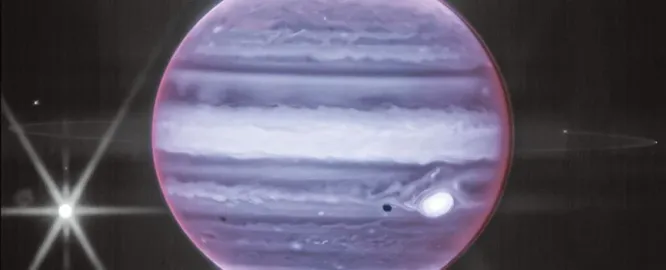Given its similarity to its neighbor Saturn, it seems natural to ask why Jupiter also doesn’t have a magnificent vast system of visible rings.

A picture of Jupiter, where you can see a barely noticeable ring NASA/ESA/CSA/STScI/Judy Schmidt
According to a new study, these rings lack “trinkets” because Jupiter’s tuple of thick Galilean moons prevents disks of rock and dust from accumulating as it does around Saturn.
To test the idea of a giant ring system forming around Jupiter at some point in its history, astrophysicist Stephen Kane from the University of California and his colleague, astrophysicist Zhexing Li, conducted a series of simulations of objects orbiting the Jupiter system.
These models took into account the orbital motion of Jupiter and its four largest moons, also known as the Galilean moons: Ganymede (which is larger than Mercury and is the largest satellite in the Solar System), Callisto, Io and Europa. The team decided to calculate how long it might take to form a ring system.
According to the model, Jupiter cannot have Saturn-style rings, and it is unlikely that he ever had them.
“Massive planets form massive moons, which prevents them from having strong rings,” Kane explained. “We found that the Galilean moons of Jupiter, one of which is the largest satellite in our Solar System, will very quickly destroy any large rings that may form.”
Currently, Jupiter’s fragile rings are mostly made up of dust ejected by some of its moons, possibly including material ejected into space as a result of collisions with other cosmic bodies. Saturn’s rings, on the other hand, are mostly made up of ice; perhaps fragments of comets or asteroids, or an icy satellite that either fell apart due to Saturn’s gravity, or collided in such a way that the ejections formed rings.
We know that Saturn’s moons play an important role in the formation and maintenance of its rings. But a big enough moon (or moons) it can also gravitationally destroy the rings, throwing ice out of planetary orbit.
It is noteworthy that not only planets can have rings. A small body about 230 kilometers across, called Chariclo, orbiting Jupiter and Uranus, has rings. Like the dwarf planet Haumea, hanging out in the Kuiper Belt with Pluto. Modeling suggests that rings around icy bodies are not uncommon due to gravitational interactions that lift ice from the surface of these bodies to form an orbital ring around it.
Mars can also sometimes have rings. Its satellite Phobos is getting closer to the Red Planet by just a little bit every year; but after 100 million years, the distance will be reduced so much that the gravity of Mars will simply tear the satellite apart, forming a short-lived ring that may eventually merge back into the moon. Even Saturn’s rings are most likely temporary, they are destined to slowly fall on the planet.
